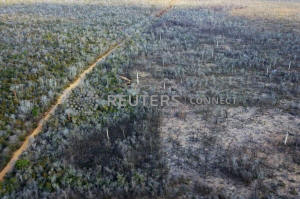Madagascar forest destruction wiping out humans' tiniest relative
 Send a link to a friend
Send a link to a friend
 [September 06, 2019]
By Rondro Ratsimbazafy and Hereward Holland [September 06, 2019]
By Rondro Ratsimbazafy and Hereward Holland
KIRINDY FOREST, Madagascar (Reuters) - As a
shocked world watches fires ravage the Amazon, slash-and-burn farmers
are wreaking proportionally worse destruction half a world away in
Madagascar, driving humanity's smallest relative - the Madame Berthe’s
mouse lemur - to extinction.
Frustrated conservationists hope Friday's arrival of the
environmentally-conscious Pope Francis will spotlight the island that
lost 2% of primary rainforest last year, the highest of any tropical
nation according to the World Resources Institute.
"He should say that this forest is God's creation. He gave it to us and
for our own benefit," said Anselme Toto Volahy, researcher from Durrell
Wildlife Conservation Trust.
"If we don't manage it well, we will destroy ourselves."

The Kirindy forest, on the west of the island, spans 100,000 hectares
(245,000 acres) but has lost almost half its size in two decades.
Wastelands of blackened stumps are broken only by scorched trunks and
twisted boughs of baobab trees resistant to fires.
Kirindy is home to a multitude of rare species, including the tiny
Madame Berthe’s mouse lemur, the world's smallest primate, which only
exists there. Bug-eyed and weighing just 35 grams (1.25 ounces), the
lemur's habitat may be completely destroyed in three years, said Volahy,
though the animal might go sooner.
Matthias Markolf, a lemur specialist at the German Primate Centre in
Kirindy, has not spotted it for two years.
"We do not find Berthe in places that we used to find it before," he
said. "It might go extinct in the next couple of years if deforestation
continues."
'THE SOIL IS DYING'
With more than 80% of its species native, Madagascar has more unique
plants and animals than the rest of Africa together.
But as well as farmers' fires, the island is facing increasingly
powerful storms and extended droughts at the sharp edge of global
climate change.
When a 2016 harvest failed in the south, thousands of farmers migrated
to the west - to Kirindy - accelerating the forest's destruction.
Unscrupulous businessmen linked to local politicians pay around 50,000
ariary ($13.40) for every hectare of forest cleared, say village elders.
It is backbreaking labor, but there is no shortage of workers in a
nation where 90 percent of people survive on less than $2 per day.
"We had to eat cactus and mango, from the morning to the evening," said
24-year-old Sonlinde Nathaly, recalling the drought that drove her and
others from the south in a migration wave that coincided with a massive
spike in deforestation.
Satellite data shows Kirindy lost 4% of its area in the last two years,
said Volahy, pacing through a clearing scattered with singed maize husks
and giant snail shells bleached white by the blaze.
After trees are felled, the area is torched to clear land for maize.
Middlemen take the crops to big cities, where the kernels become
untraceable, potentially entering the supply chain for big companies.
"Since 2013 we have worked with people from the government. The deal
was, we cut (the forest) and grow maize," said Nahità, vice president of
the local administration in Lambokely, a dusty village that used to hug
thick forest.
[to top of second column]
|

Burnt trees are seen Menabe Antimena protected area near the city of
Morondava, Madagascar, September 1, 2019. REUTERS/Baz Ratner

Now the wooden houses cluster forlornly in a barren landscape. The
shallow soils are worn out after three harvests of maize and
peanuts, driving farmers further into the forest.
"The soil is dying," said Phrosalia Soriana, a 36-year-old farmer.
"The people in charge of the forest tell us that we are doing
wrong." But, she asks, how else can she feed her family?
UNTOUCHABLES?
In the past nine months, the government has made some efforts to
slow the destruction, arresting several farmers and destroying corn
in the protected area.
But bigger players remain free.
"To totally eradicate the problem, we have to touch the
untouchables," said Liana Rakotoson from Fanamby, a local
conservation group investigating the maize business in Kirindy.
Prosecutors want to go after politicians involved and big companies
that buy the maize.
But Andrianirina Francis, deputy prosecutor for Menabe region, said
building a case is hard because farmers' maize crops are mixed
before being sold on.
"The product passes through many hands," he said.
However, big companies, like national brewery the STAR group, have a
responsibility to know their suppliers, he insisted. "Tons and tons
and tons of corn come from the destruction of the forest," Francis
said, but "STAR never asks where their product comes from."
Since 2011, French beverage company Castel has owned STAR, which is
also Coca-Cola's Madagascar bottling partner.
Castel and Coca-Cola did not respond to requests for comment.
Francis Ambroise, the general manager of STAR in Madagascar, said
the company accounted for only around 2% of the maize market. Most
went to feed cattle, he said.
“The company has supply contracts preventing sellers from sourcing
their maize from the forest or any other protected area," he told
Reuters.
“We work with (environmental group) Fanamby to control our
suppliers, respect the contracts’ clauses and to ensure the
traceability of our maize supply ... using maize from protected
areas would be against what we consider to be our society
responsibility.”

But Tiana Andriamanana, executive director of Fanamby, said "the
chaotic market makes traceability impossible."
"Everybody sees the trucks of maize coming back and forth, usually
at night, but nobody records where they go."
(Reporting by Rondro Ratsimbazafy and Hereward Holland; Additional
reporting by Inti Landauro in Paris; Editing by Katharine Houreld
and Andrew Cawthorne)
[© 2019 Thomson Reuters. All rights
reserved.]
Copyright 2019 Reuters. All rights reserved. This material may not be published,
broadcast, rewritten or redistributed.
Thompson Reuters is solely responsible for this content. |